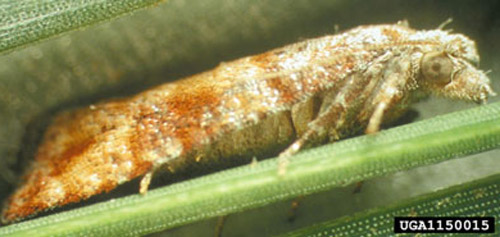In October 2018, Hurricane Michael rolled through the Central Panhandle, destroying millions of acres of commercial pine forests. In the years since, a remarkable amount of work has been done to clean up and replant most of these destroyed acres. Many of these post-hurricane planted acres were replanted in improved selections of Loblolly Pine (Pinus taeda), the most common species in the Southeast timber industry and a strong performer on many Panhandle sites. While Loblolly is an excellent choice for local timber growers, producing a large volume of wood in a relatively short amount of time, it does have an Achilles’ heel in its younger years – the Nantucket Pine Tip Moth.

The Nantucket Pine Tip Moth. Credit: Bugwood.org.
–
Pine Tip Moth Life Cycle and Damage
Native to much of the U.S., the Nantucket Pine Tip Moth is a serious pest of young pine trees (~first five years of growth) in plantations, nurseries, and other settings. And while the Pine Tip Moth is known to bother around twenty species of pines in North America, unfortunately for Panhandle producers, its absolute favorite host is the Loblolly Pine. As with most Lepidoptera pests, the Pine Tip Moth does its damage in the larval stage. In Florida, moths emerge and begin to mate in spring after the weather warms. Female pine tip moths then lay their eggs on new pine shoots, conelets, or the previous year’s growth. After hatching, larvae feed on the outside of these growing points for a short while before making their way inside. Once Tip Moth larvae bore their way into growing pine shoots, they continue to feed for a month or so, destroying the shoot tissue as they go, before undergoing pupation and repeating the cycle. Though the damage is often done in early-mid summer, timber growers often don’t notice it until late summer-early fall when normally green pine shoots begin to turn an ominous brown. Severely affected trees exhibit considerable early life growth loss and deformity due to Tip Moth damage. The damage that Pine Tip Moths wreak upon young Loblolly plantations is particularly striking when observed next to a virtually unaffected Slash Pine stand.
–
Is Pine Tip Moth Damage on Loblolly Pine Permanent?

Pine Tip Moth damaged and stunted 3-year old planted Loblolly Pine seedling (left) contrasted with unaffected Slash Pine volunteer seedling (right). Credit: Daniel Leonard, UF/IFAS
Comparing your tip-blighted Loblolly stand with your neighbor’s damage-resistant Slash stand invariably invites hurt feelings and the question, should growers quit planting Loblolly, the workhorse of pine plantations across the South? The short answer is, probably not. While it isn’t uncommon for young Loblolly stands in areas of extreme infestation to have nearly 100% of trees affected, Tip Moth damage tends to be temporary. Severely affected trees will be set back somewhat, some trees will exhibit malformities, and early life wood volume production will be affected, but otherwise healthy stands on good sites will eventually grow out of the damage. Once trees reach 5-6 years of age, 10-15’ in height, and their canopies begin to grow together, Pine Tip Moths cease to be a problem and leave to seek out new areas to annoy.
–
What Can Loblolly Pine Growers do to Lessen Pine Tip Moth Damage?
Unfortunately, pesticide application for Tip Moth control is not usually practical or cost effective. The primary thing that growers can do to lessen Tip Moth damage is to plant improved Loblolly seedlings only on optimal sites with optimal spacing between trees/rows. Tip Moth damage is worst in plantations on dry, sandy sites that were planted with unimproved seedling varieties in widely spaced rows – avoiding these can certainly lessen potential heartache. Surveys in the Gulf region of Texas have also shown that Tip Moth damage increases as silvicultural intensity increases. This means site prep practices like herbicide application to reduce weed competition and mechanical site preparation (chopping, bedding, etc.), while known to boost pine seedling growth dramatically, can cause Pine Tip Moth infestations to be more severe. Therefore, be mindful when choosing site preparation options that you don’t create more problems than you solve. Finally, if the thought of your Loblolly Pine seedlings’ growing tips turning brown and potential growth setbacks is not something you’d like to deal with, planting Slash Pine (if the site is suitable for it) is always an option
For more information on Nantucket Pine Tip Moth damage, pine species selection, or any other forestry question, contact your local UF/IFAS County Extension Office.
- Panhandle Cotton Acres Are Down in 2025– Here’s the Reason - July 11, 2025
- It Snowed, But Has This Been a Historically Cold Winter? What the Data Says. - January 31, 2025
- 2025 Fish Camp Webinar Series– February 10,17, & 24 - January 31, 2025
